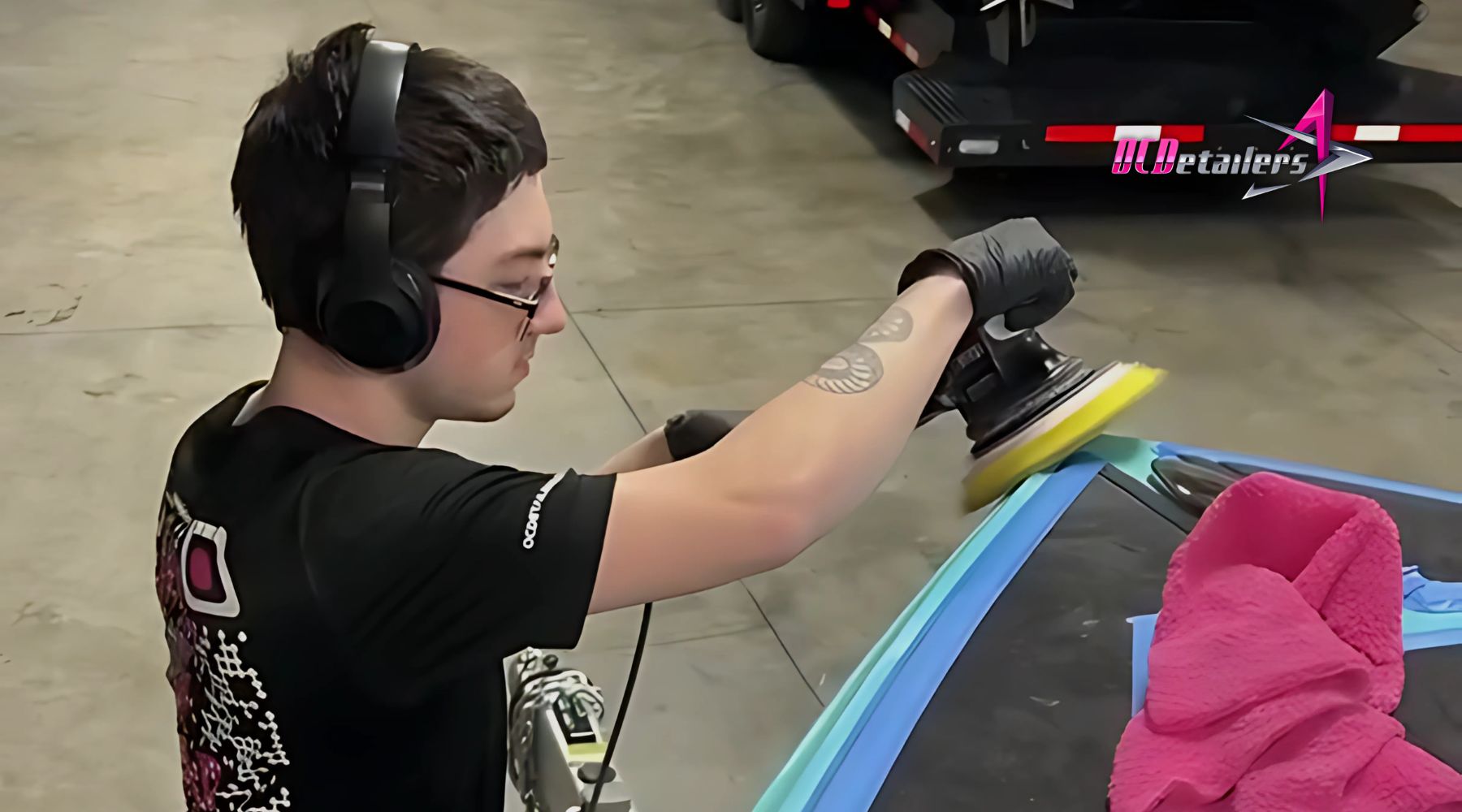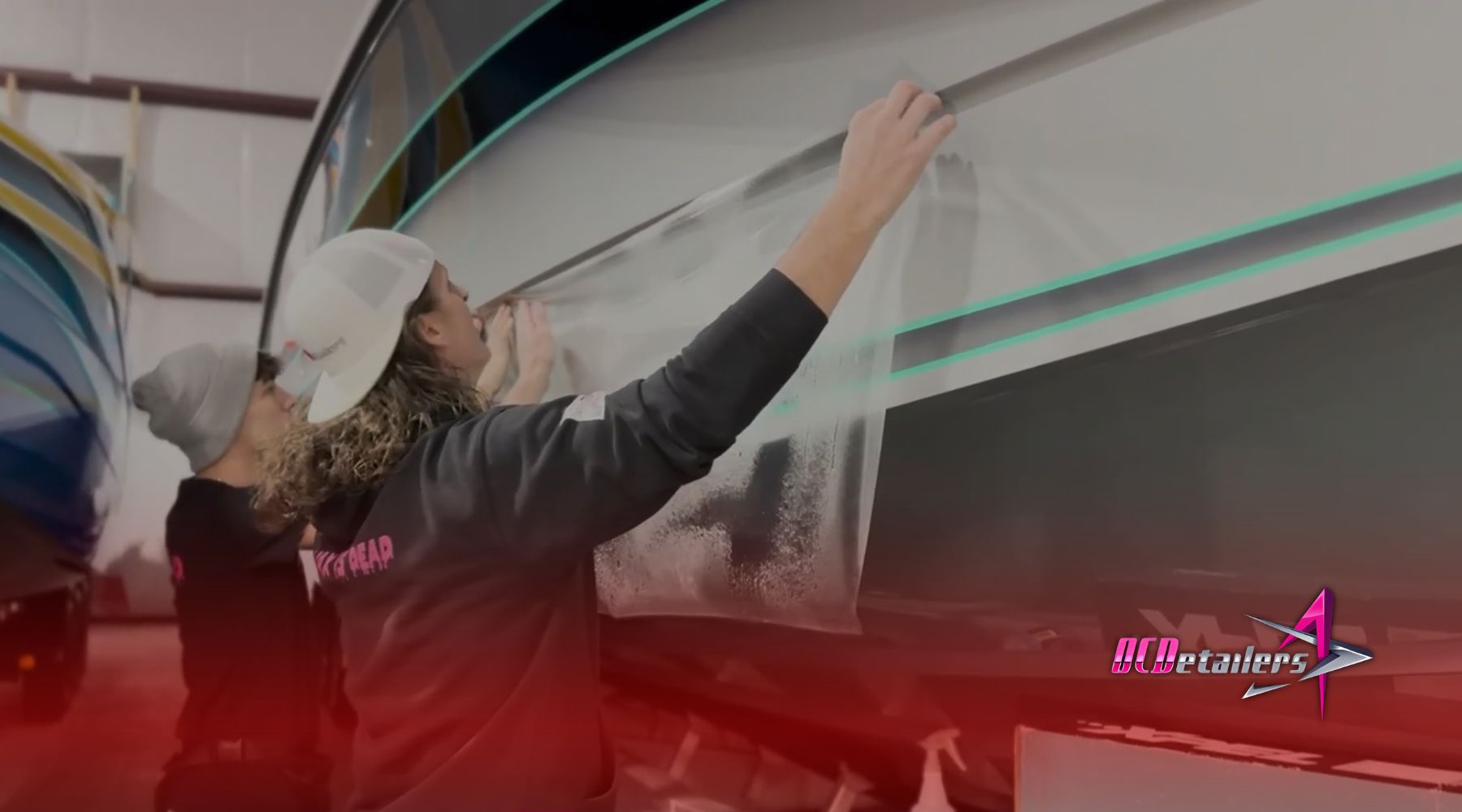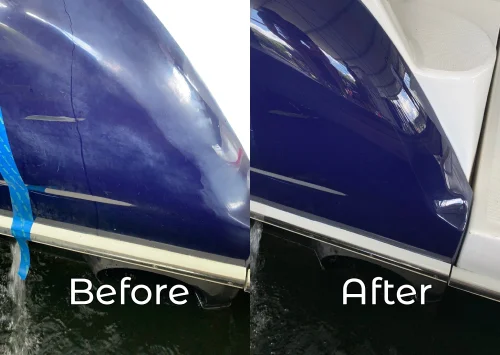Boating in Osage Beach offers unforgettable experiences on the shimmering waters of Lake of the Ozarks. But as any seasoned boater knows, those serene moments come with a price, constant exposure to sunlight, docking hazards, waterborne debris, and fluctuating weather conditions. These factors contribute to the wear and tear of your vessel’s hull, often resulting in costly repairs and diminished appearance.
That’s where Paint Protection Film (PPF) comes into play. In this article, we explore the role of PPF in safeguarding your boat from damage, with a special focus on the boating conditions in Osage Beach.
Marine Protection Film Explained: The Invisible Armor for Your Boat
Marine Paint Protection Film (PPF) acts like a high-tech shield for your boat’s most vulnerable areas, particularly the hull. Made from durable polyurethane film, this transparent layer is engineered to guard against the harsh realities of marine life, especially in active boating regions like Osage Beach.

Unlike traditional wax or sealants, PPF delivers multi-layer protection that includes:
- Impact resistance to prevent scratches and chips from trailers, docks, and other vessels
- UV blocking properties to reduce sun-induced fading and marine UV degradation
- Self-healing capabilities that erase minor surface marks with heat or sunlight
- Hydrophobic effects that repel water, algae, and grime, reducing cleaning time
- Saltwater and mineral resistance that protects against corrosion and buildup
When installed by experts like OCDetailers, marine protection film is precision-fitted to your boat’s curves, creating a seamless, nearly invisible barrier that preserves your boat’s appearance and extends its life.
Whether you’re navigating crowded marinas or cruising open water, marine protection film ensures your vessel stays protected, polished, and ready for every adventure.
Why Osage Beach Boats Face Unique Hull Challenges
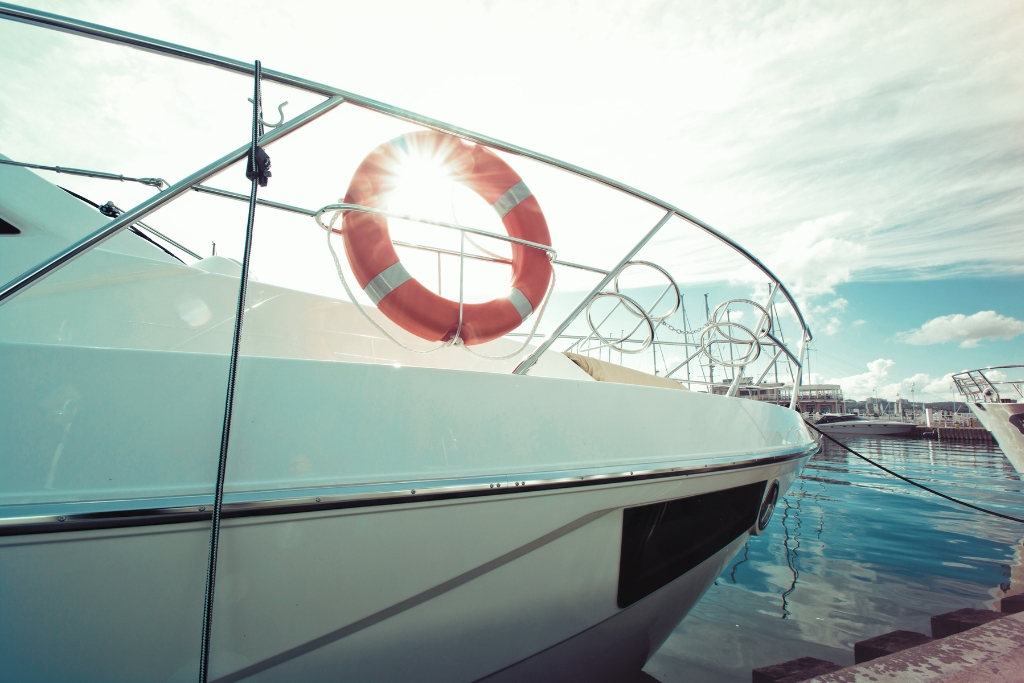
Nestled in the heart of Lake of the Ozarks, Osage Beach is a bustling hub for recreational boating. But with that popularity comes a unique set of environmental and situational challenges that can take a toll on your boat’s hull.
- Docking Damage: High marina traffic, tight slips, and frequent loading or unloading increase the chance of accidental contact with docks, pilings, and neighboring vessels, leading to unsightly scratches and scuffs.
- Sun Exposure: Boats spend extended hours under intense UV rays, especially during peak season. This accelerates gelcoat oxidation, discoloration, and surface dulling, particularly on the hull’s exposed surfaces.
- Waterborne Debris: Wind, wakes, and weather push debris like branches, plastic, and algae toward shorelines and marina zones, directly into contact with unprotected hulls. Over time, this causes abrasions and the embedding of contaminants.
- Seasonal Shifts: The area experiences hot, humid summers and cold winters. This fluctuation contributes to thermal expansion and contraction of the hull’s materials, which can stress protective coatings and lead to cracking or peeling.
- Wake and Wave Activity: Heavy boat traffic generates consistent wave impact, especially near popular beaches and coves. These micro-impacts wear down surfaces faster if they’re not adequately shielded.
Without robust protection like PPF, Osage Beach boats are far more vulnerable to accelerated wear, fading, and costly maintenance, compromising both performance and value over time.
Key Benefits of PPF for Boats in Osage Beach
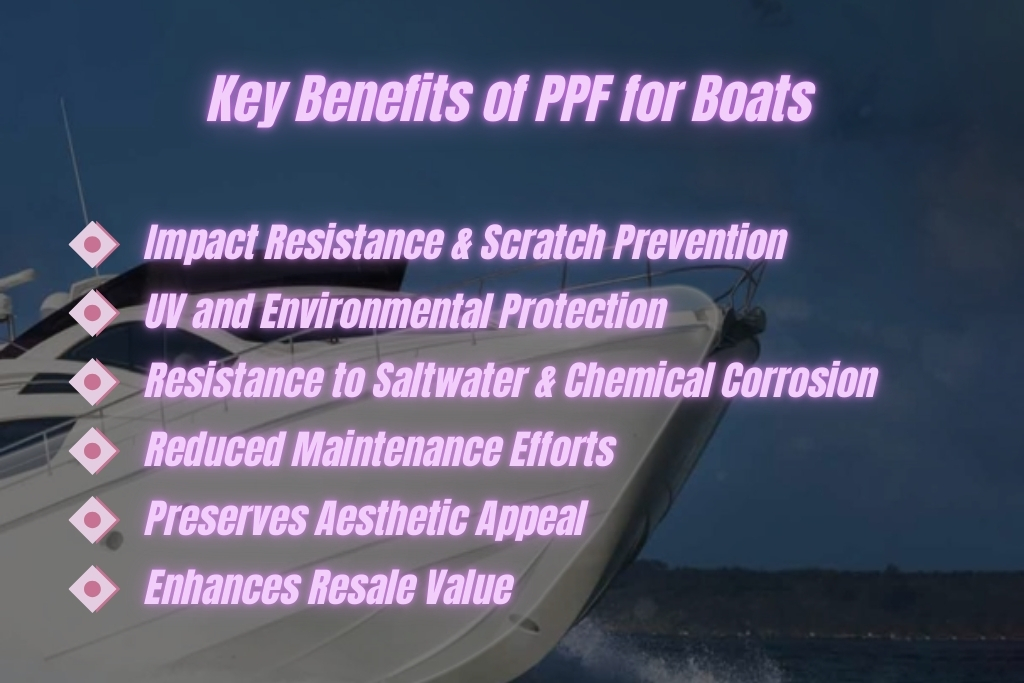
1. Impact Resistance & Scratch Prevention
PPF creates a resilient barrier that absorbs small impacts and scratches from docking, trailers, or equipment. Whether you’re maneuvering through a tight marina or navigating floating obstacles, PPF acts as your first line of defense.
2. UV and Environmental Protection
Osage Beach sees extended periods of direct sunlight. Over time, this leads to discoloration and degradation of your boat’s gelcoat. PPF blocks harmful UV rays, preventing marine UV degradation, yellowing, and chalking.
3. Resistance to Saltwater & Chemical Corrosion
Even though Lake of the Ozarks is freshwater, some boaters trailer their vessels to coastal destinations. Marine Protection Film provides protection against both environments. PPF resists saltwater corrosion, fuel stains, and harsh cleaning chemicals, keeping your hull smooth and intact.
4. Reduced Maintenance Efforts
Thanks to its hydrophobic properties, PPF repels algae, dirt, and grime, making cleaning easier and faster. That means fewer hours scrubbing and more time enjoying the lake.
5. Preserves Aesthetic Appeal
With its glossy, seamless finish, Marine Protection Film enhances your boat’s appearance, making it look newer for longer. It also protects against wake damage and surface discoloration caused by prolonged sun or water exposure.
6. Enhances Resale Value
A well-maintained hull reflects better ownership. By maintaining its aesthetic and structural integrity, PPF helps preserve resale value and reduces the need for costly repairs or refinishing.
PPF vs. Ceramic Coating: Which is Better for Your Boat?
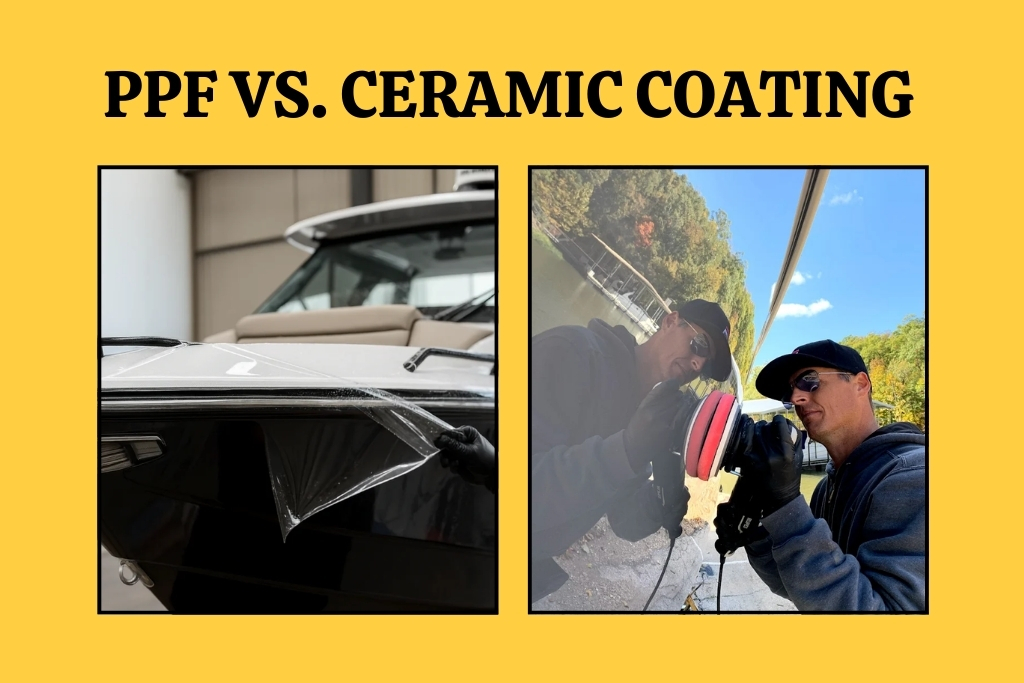
While both Paint Protection Film (PPF) and ceramic coatings serve to protect your boat, they function in very different ways, and choosing the right one depends on your protection goals.
- PPF is your go-to solution for physical defense. It acts as a sacrificial barrier that absorbs dings, scratches, and scuffs from docking, trailering, and debris impact. It also offers UV resistance and minor self-healing capabilities, making it ideal for high-wear areas like the hull, transom, and bow.
- Ceramic coating, on the other hand, provides a chemical layer of protection. It boosts your boat’s gloss, enhances color depth, and makes the surface slick and water-repellent. It’s effective against stains, UV rays, and oxidation, but does not shield against physical impact or abrasions.
For the best of both worlds, many boat owners in Osage Beach choose to combine both. At OCDetailers, we recommend applying Marine Protection Film (PPF) where protection is most needed, then layering ceramic coating over the rest of the vessel to maximize shine, reduce maintenance, and extend the overall lifespan.
Why Choose OCDetailers for Marine Protection Film in Osage Beach?
When it comes to protecting your boat, experience matters, and no one understands marine protection in Osage Beach like OCDetailers.
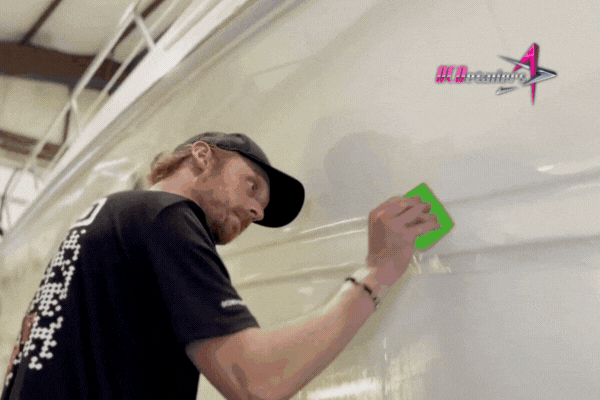
With years of hands-on expertise in paint protection film and ceramic coating applications, our team is trusted by boat owners across Lake of the Ozarks for precision, professionalism, and premium results. We use only top-tier, marine-grade films and deliver expert installation that withstands real-world conditions, including sun, salt, wake, and wear.
Here’s why boat owners choose OCDetailers:
- Certified and trained PPF specialists
- Locally owned with deep knowledge of Osage Beach boating conditions
- Custom protection packages to fit every boat and budget
- Honest service, no unnecessary upsells, just what your boat really needs
- Two convenient locations: Osage Beach and Chesterfield, MO
Whether you need full-hull protection or targeted coverage for high-impact areas, we’ll help you extend your boat’s beauty and performance, season after season.
Ready to protect your investment?
Contact OCDetailers today to request a quote or schedule a consultation.
Installation & Maintenance Tips
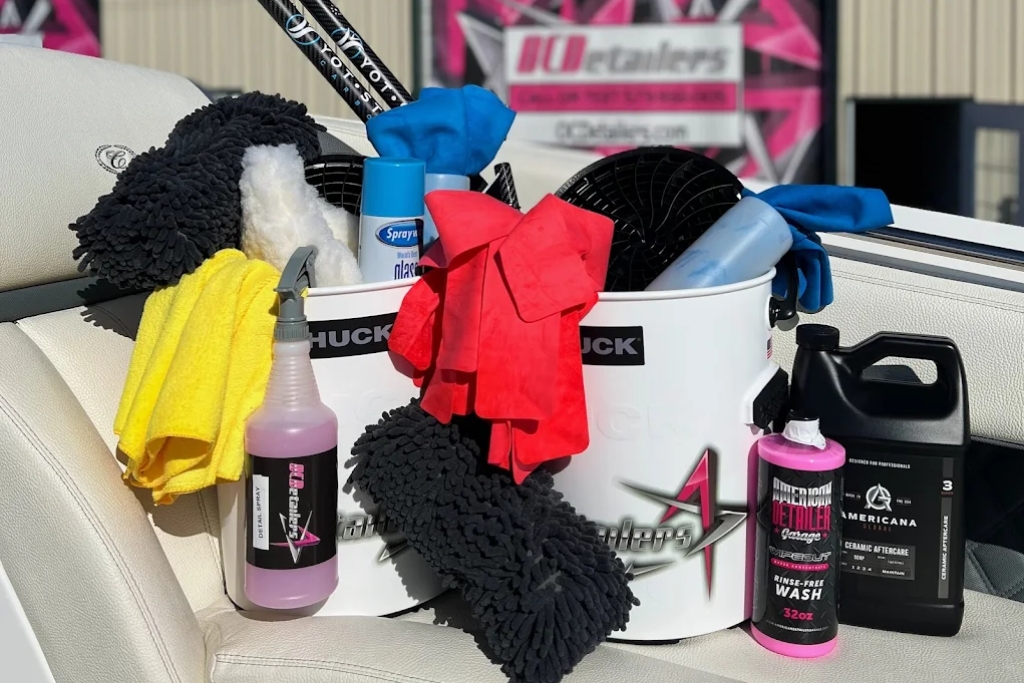
Choosing the Right Installer
Applying Marine Protection Film isn’t a DIY job; it requires precision, surface prep expertise, and knowledge of marine-specific materials like gelcoat and non-skid surfaces. That’s why it’s essential to work with certified professionals like OCDetailers in Osage Beach. Our team has specialized training in boat PPF installation, ensuring a seamless, bubble-free finish that adheres properly and lasts through rugged lake conditions.
A poor installation can lead to lifting, edge failure, or even damage to the underlying surface, issues that cost more to fix than doing it right the first time.
Maintenance Tips to Maximize Lifespan
Once your PPF is installed, a few simple maintenance habits will keep it looking and performing its best:
- Use pH-neutral, marine-safe soaps to prevent chemical damage to the film.
- Rinse thoroughly after every trip, especially after exposure to lake water, algae, or contaminants.
- Avoid abrasive brushes, sponges, or harsh degreasers that could dull or lift the film.
- Dry with microfiber towels to prevent water spots and streaks.
- Inspect high-impact areas (bow, transom, waterline) regularly for signs of wear or lifting.
- Schedule professional detailing twice a year, ideally at the start and end of boating season, for deeper cleaning and inspection.
Following these simple steps ensures your PPF remains crystal-clear, glossy, and effective for years, helping you protect your boat’s value and enjoy every ride worry-free.
Making the Most of PPF Lifespan
In a boating hotspot like Osage Beach, protecting your vessel isn’t optional; it’s essential. The role of PPF in preserving your boat’s hull cannot be overstated. From UV defense and impact resistance to aesthetic preservation and maintenance savings, PPF is a long-term solution that pays for itself in peace of mind.
If you’re serious about keeping your watercraft in top shape, OCDetailers offers expert boat detailing and protection services tailored to the conditions of the Lake of the Ozarks. Whether you’re cruising at sunset or docking after a weekend adventure, Marine Protection Film ensures your boat looks as good as it performs.
Interested in protecting your boat’s future?
Contact OCDetailers in Osage Beach today for a custom quote or to learn more about our marine protection film (PPF) and ceramic coating packages.
Can you put PPF on a boat?
Yes, absolutely! Marine-grade PPF is specially designed for boats and can be applied to various areas, including the hull, transom, and swim platforms.
How much does marine protection film cost?
Costs vary based on coverage area and boat size, typically ranging from $1,500 to $5,000+. Custom solutions are available through OCDetailers.
What is the best way to clean a boat hull to protect the environment?
Use biodegradable, phosphate-free marine soaps and avoid washing directly near the shoreline. Rinse with fresh water and use microfiber cloths to minimize pollution.
Why is PPF important for protecting a boat hull in Osage Beach?
The high UV exposure, crowded marinas, and debris in Lake of the Ozarks make hulls susceptible to damage. PPF shields against these threats, preserving both function and appearance.
Why do boats in Osage Beach experience more hull damage than in other areas?
Osage Beach’s popularity leads to heavy boat traffic and wake turbulence. Combined with intense sunlight and fluctuating temperatures, this creates ideal conditions for hull wear.
Why is traditional waxing not enough for long-term hull protection?
Waxing offers temporary protection and lacks impact resistance. It must be reapplied frequently and doesn’t guard against scratches or UV degradation.
Why should boat owners choose PPF over ceramic coating?
Ceramic coatings enhance shine and ease of cleaning, but don’t protect against dings, docking damage, or surface scratches like PPF does. PPF is the better choice for structural protection.


